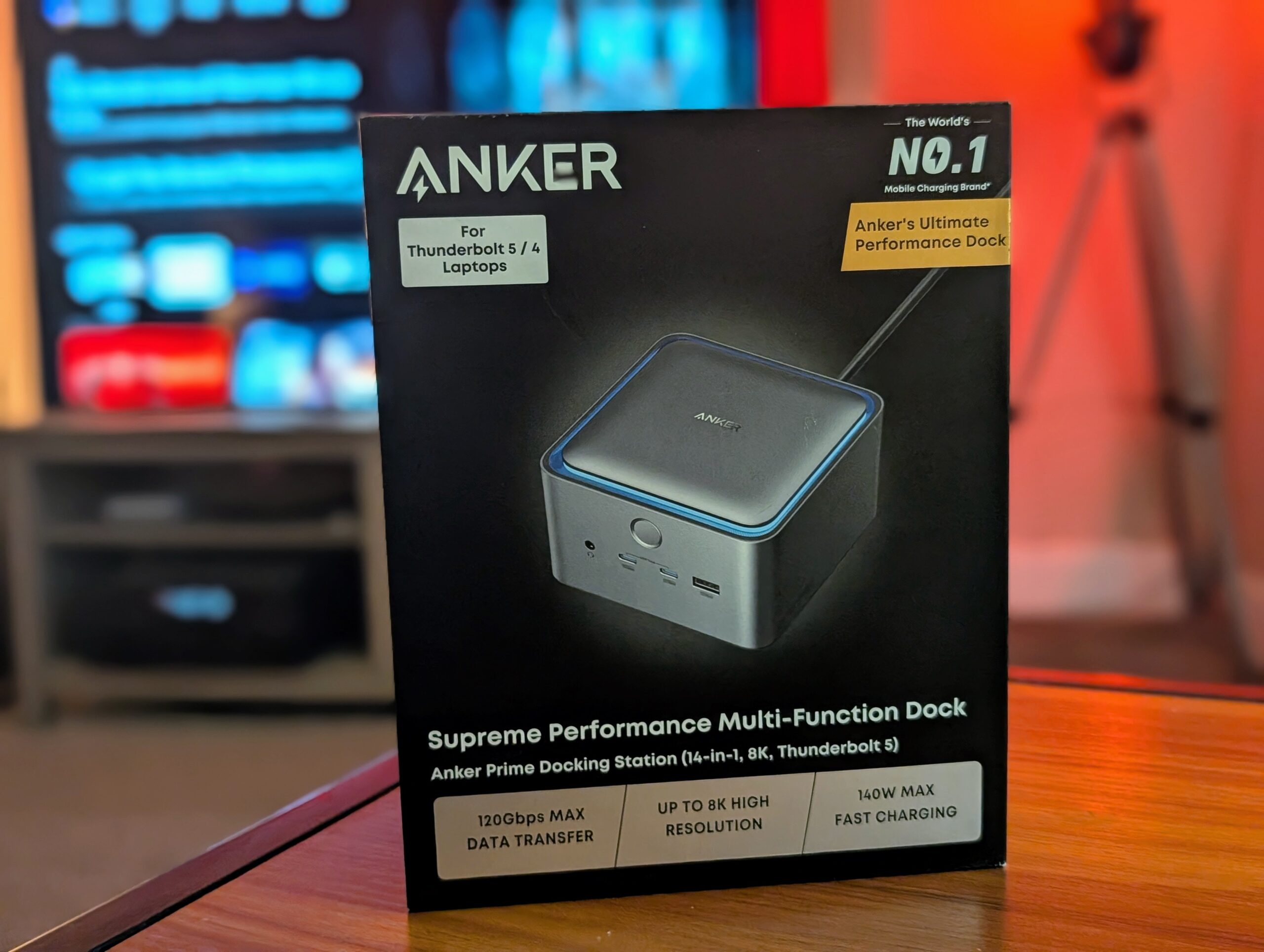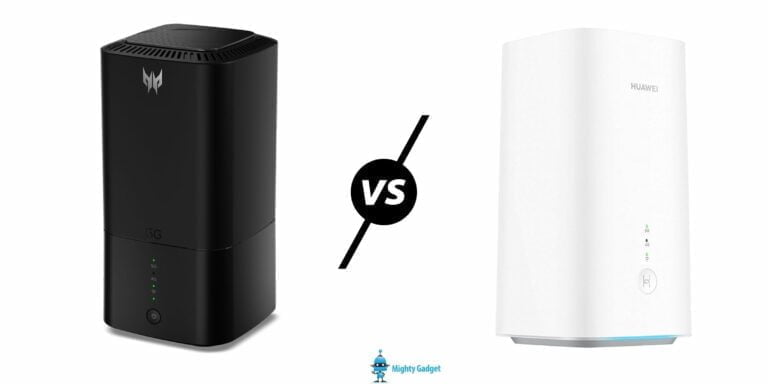Any links to online stores should be assumed to be affiliates. The company or PR agency provides all or most review samples. They have no control over my content, and I provide my honest opinion.
The Anker Prime TB5 Docking Station arrives at a time when Thunderbolt 5 technology is just beginning to appear in the latest Macs and high-end Windows machines. This dock offers a comprehensive solution for users looking to expand their connectivity options while future-proofing their setup. With 14 ports, integrated power delivery up to 140W, and data transfer speeds reaching 120Gbps, this dock aims to be a central hub for all your peripheral needs.
| Preview | Product | Rating | Price | |
|---|---|---|---|---|

| Anker Prime TB5 Docking Station, 14 Ports Thunderbolt 5... |
£399.99 | Buy on Amazon |
Related Reviews
- OWC Thunderbolt Go Dock Review with 2x Thunderbolt 4 Device Ports & 2.5 Gigabit Ethernet
- AVerMedia X’TRA GO GC515 Review
- Ugreen Revodok Max 213 Thunderbolt 4 Dock Review
- Ugreen Revodok Pro Series 313 13-in-1 & 210 10-in-1 USB-C Dock Review
- Best USB-C Docks with 2.5gbps Ethernet
- Ugreen Revodok Pro 209 9-in-1 USB-C Docking Station Review
Comparison Table: Thunderbolt 5 vs Thunderbolt 4 vs USB4
| Feature | Thunderbolt 5 | Thunderbolt 4 | USB4 |
| Maximum Bandwidth | 120 Gbps (asymmetric) | 40 Gbps | 20-40 Gbps (implementation dependent) |
| Display Support | Multiple 8K displays | Two 4K displays or one 8K@60Hz | Typically one 4K@60Hz (varies) |
| Maximum Power Delivery | Up to 240W | Up to 100W (min 15W required) | Up to 100W |
| PCIe Bandwidth | 64 Gbps (PCIe Gen4 x4) | 32 Gbps (PCIe Gen3 x4) | Up to 32 Gbps (implementation dependent) |
| Daisy Chaining | Supported (multiple TB devices) | Supported (up to 6 devices) | Limited/Variable support |
| Minimum Speed Requirements | 120 Gbps (upstream) | 40 Gbps | Can be implemented at 20 Gbps |
| Backward Compatibility | Yes, with TB4, TB3, USB4, USB-C | Yes, with TB3, USB-C | Yes, with USB-C |
| External GPU Support | Yes (enhanced) | Yes (required) | Optional |
| Wake from Sleep | Yes | Yes | Optional |
| Certification Requirements | Strict (Intel) | Strict (Intel) | Less strict (USB-IF) |
| Market Adoption | Beginning (2025) | Widespread (since 2020) | Growing (since 2019) |
Ports / Features
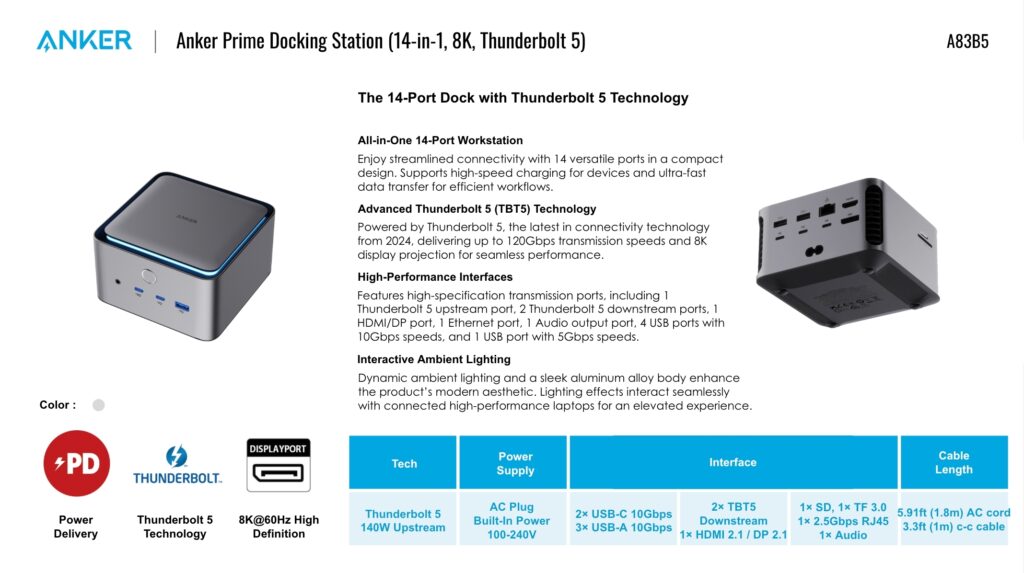
- One upstream Thunderbolt 5 port (80Gbps, 140W)
- Two downstream Thunderbolt 5 ports (80Gbps, 15W)
- One HDMI 2.1 port
- One DisplayPort 2.1 port
- Three USB-A ports (10Gbps, 1x 7.5W, 2x 4.5W)
- Two USB-C ports (10Gbps, share 45W)
- Ethernet (2.5Gb)
- SD card reader (UHS-I, 104MBps)
- microSD card reader (UHS-I, 104MBps)
- 3.5mm combo audio jack (front)
- 232W Integrated GaN Power Supply
- Advanced Cooling System
- To maintain performance under sustained loads, the dock employs a precision-engineered U-shaped air duct, a built-in turbo fan, and smart temperature control algorithms. This system is designed to keep surface temperatures stable and the device operating quietly, even during intensive data transfers or when powering multiple high-draw devices.
- Smart Firmware Management
- Anker includes its Dock Manager software, which supports remote and model-specific firmware updates. This targeted approach helps prevent unnecessary system-wide updates that could introduce instability or compatibility issues, especially in environments where multiple docking stations are deployed.
Unboxing / Design
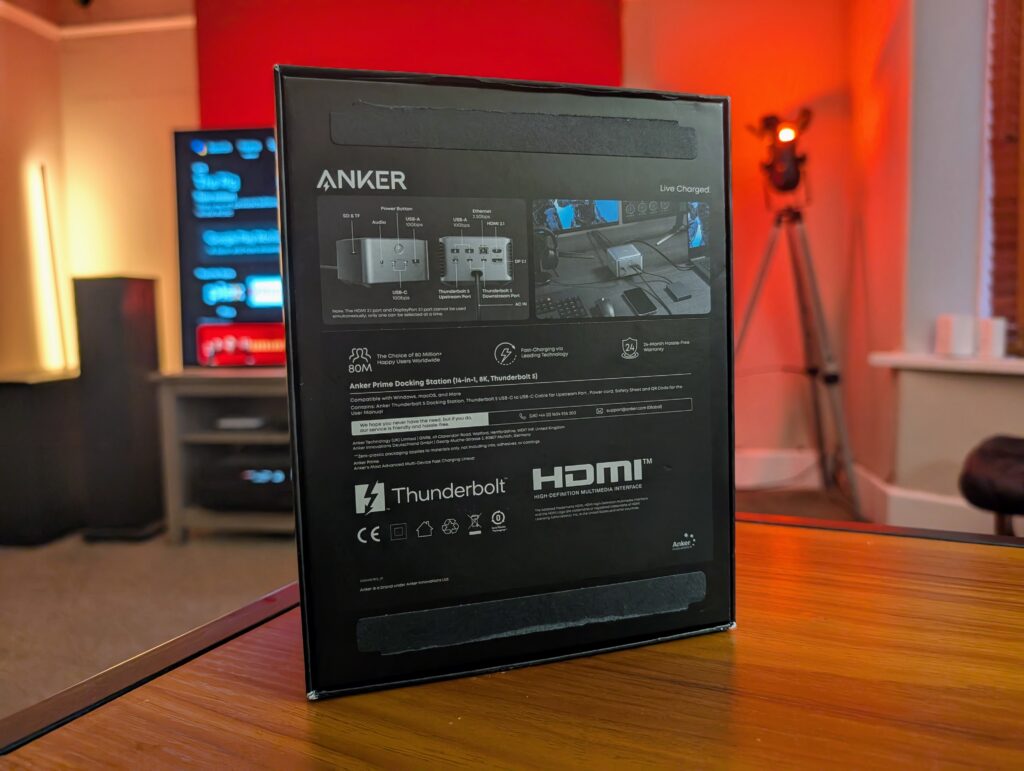
The Anker Prime TB5 Docking Station arrives in a premium package that includes the dock itself, a Thunderbolt 5 cable, and a power cable. Notably absent is a power brick, as the power supply is integrated directly into the dock-a significant advantage over many competing products.
The dock features a vertical standing design reminiscent of a Mac mini, with an aluminium alloy construction that feels substantial and premium. The vertical orientation helps with heat dissipation and minimises desk footprint, though it does make the unit taller than some horizontal alternatives.
At the top of the dock is an ambient LED light ring that provides visual feedback about the dock’s status. The front panel houses easily accessible ports including two USB-C ports, a USB-A port, and a 3.5mm audio jack, while the rear contains the majority of the connectivity options.
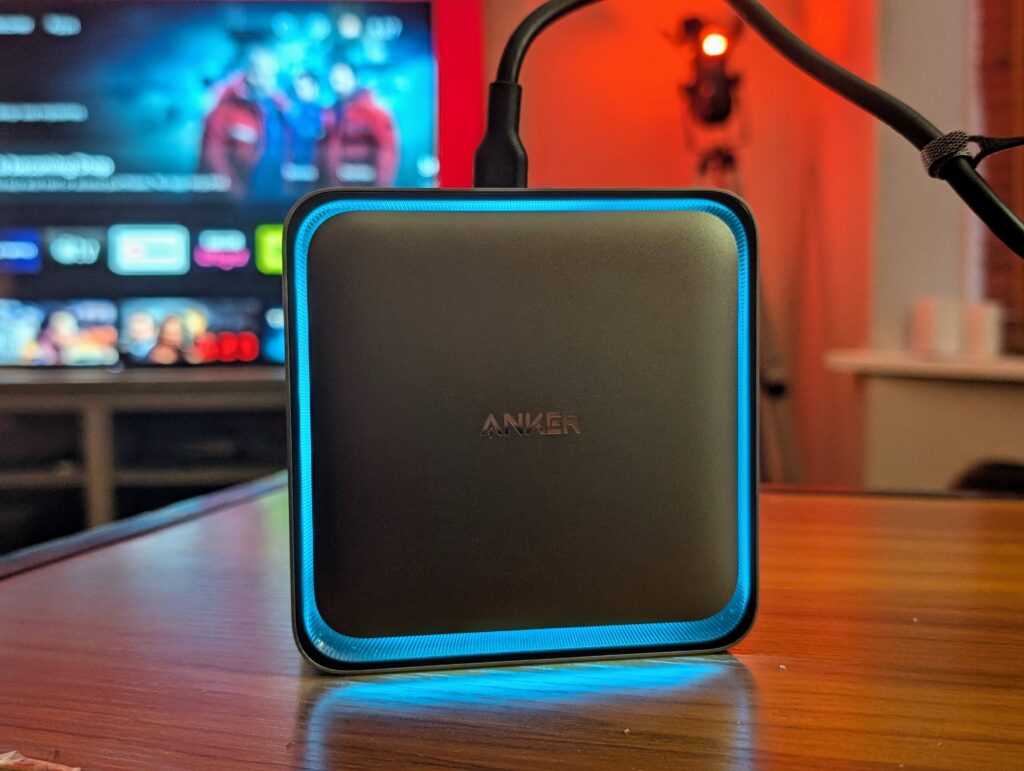
The build quality is excellent, with a solid feel and weight that prevents the dock from sliding around when cables are connected or disconnected. The rubber feet provide additional stability on desk surfaces.
One of the most notable design features is the integrated cooling system. The dock features a unique U-shaped air duct and cooling fan that employs an ‘intelligent temperature algorithm’ to prevent overheating during intensive use. This design creates a controlled convection current, allowing cool air to enter through intake vents at the base and exit through exhaust ports near the top.
The curved geometry maximises surface area for heat dissipation while maintaining the dock’s compact vertical form factor. A 4,200 RPM axial fan operates in tandem with the air duct, dynamically adjusting its speed based on real-time thermal sensors. Unlike traditional docking stations that use constant fan speeds, this system scales from near-silent 800 RPM operation during light loads to full-speed cooling during sustained 120Gbps data transfers.
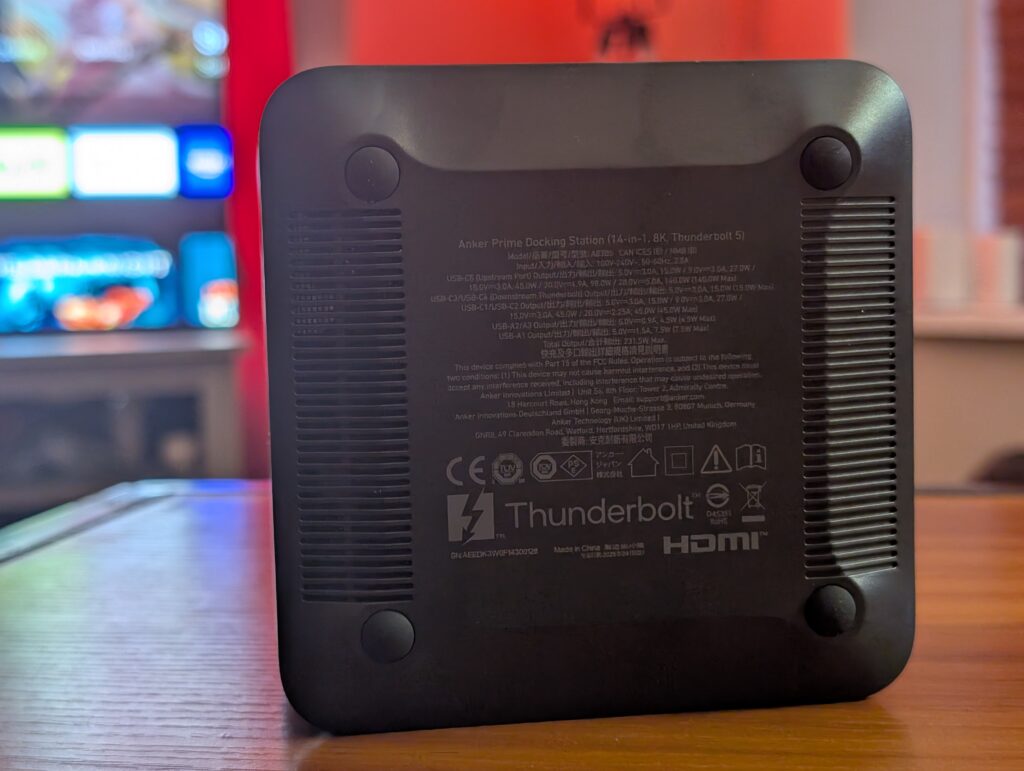
Thunderbolt 5
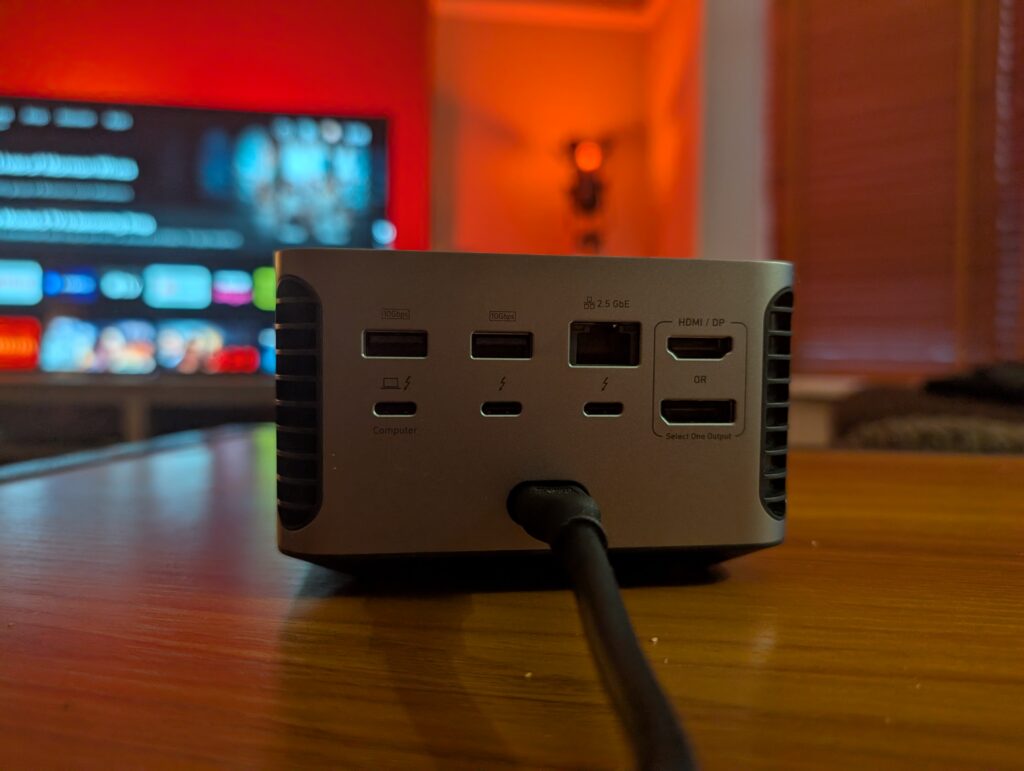
Thunderbolt 5 represents a substantial upgrade over previous generations, doubling the baseline bandwidth to 80Gbps and, with Bandwidth Boost, reaching up to 120Gbps in one direction. This increased bandwidth is particularly beneficial for high-resolution displays and data-intensive tasks, enabling support for up to three 4K displays at 144Hz or two 8K displays at 60Hz.
In comparison, Thunderbolt 4 offers a maximum bidirectional bandwidth of 40Gbps, which is sufficient for most external storage, displays, and docking applications, supporting up to two 4K displays or one 8K display.
USB4 shares much of its underlying technology with Thunderbolt 4, supporting up to 40Gbps. However, not all USB4 devices are required to support the maximum speed; some may only offer 20Gbps. This variability means users must check device specifications carefully.
The Anker Prime TB5 takes full advantage of Thunderbolt 5’s capabilities, offering impressive data transfer speeds and display support. When connected to a compatible device, users can experience the full 80Gbps bandwidth, with the potential for 120Gbps in one direction through Bandwidth Boost.
Thunderbolt 3 & 4 Support
It’s worth noting that this dock does not support Thunderbolt 3 laptops but is compatible with Thunderbolt 5, 4, or USB4 laptops. Additionally, some USB4 laptops may not support dual monitors, so it’s essential to check your device’s specifications before purchase.
While the dock is backward compatible with Thunderbolt 4 devices, users will be limited to Thunderbolt 4’s 40Gbps bandwidth rather than the full 80-120Gbps offered by Thunderbolt 5. This limitation is inherent to the device’s capabilities rather than the dock itself.
For users with Thunderbolt 4 devices considering an upgrade to Thunderbolt 5 in the future, this dock represents a solid investment that will scale with your hardware. The backward compatibility ensures that you can use the dock with your current setup while being prepared for future upgrades.
Power Delivery
One of the standout features of the Anker Prime TB5 Docking Station is its power delivery capabilities. The dock can deliver up to 140W to the host device through the upstream Thunderbolt 5 port, which is sufficient for fast-charging even high-end laptops like the 16-inch MacBook Pro.
Thunderbolt 5 increases the maximum power delivery to 240W, accommodating more demanding devices, including high-performance laptops and workstations. While the Anker Prime TB5 doesn’t reach this maximum, its 140W output is more than sufficient for most users.
In comparison, Thunderbolt 4 supports up to 100W of power delivery, suitable for most laptops and peripherals, while USB4 can also support up to 240W of power delivery, but this is not mandatory for all devices.
The dock’s front USB-C ports share a total of 45W of charging power, which is adequate for powering smaller laptops or multiple devices like smartphones. The USB-A ports also offer charging capabilities, with the front port delivering 7.5W-sufficient for fast-charging an Apple Watch-while the two rear ports provide 4.5W each, suitable for devices like memory sticks, keyboards, or mice.
A significant advantage of the Anker Prime TB5 is its integrated GaN power supply, which eliminates the need for an external power brick. This not only reduces clutter on and under your desk but also makes the dock more portable and travel-friendly. The built-in GaN technology also reduces heat generation by 23% compared to traditional silicon-based adapters.
USB ports
The two downstream Thunderbolt 5 ports can function as USB-C ports if Thunderbolt speeds aren’t required, providing flexibility for different devices.
On the front panel, two USB-C ports offer 10Gbps data transfer speeds and share a total of 45W of charging power. This is particularly useful for quickly connecting and charging devices like smartphones, tablets, or smaller laptops.
The dock also includes three USB-A ports, all capable of 10Gbps transfer speeds. The front USB-A port delivers 7.5W of power, making it ideal for fast-charging devices like an Apple Watch. The two rear USB-A ports provide 4.5W each, sufficient for powering peripherals like keyboards, mice, or memory sticks.
All USB ports on the dock support USB 3.2 Gen 2 speeds (10Gbps), which is a step up from many docks that still use USB 3.2 Gen 1 (5Gbps) for some or all of their USB-A ports. This ensures that even when connecting older USB-A devices, you’ll still get excellent performance.
Display Output
- Thunderbolt 4: Supports up to two 4K displays at 60Hz or one 8K display.
- Thunderbolt 5: Expands this to three 4K displays at 144Hz or two 8K displays at 60Hz, thanks to the higher available bandwidth and support for DisplayPort 2.1.
- USB4: Display support varies by device implementation, with some supporting dual 4K displays, but not all devices meet the same minimum requirements as Thunderbolt.
The Anker Prime TB5 Docking Station offers versatile display output options, supporting various configurations to meet different needs. Users can connect one or two monitors through the dedicated video ports (DisplayPort and/or HDMI) or the downstream Thunderbolt 5 ports.
For MacBook users with Pro or Max M-series processors, the dock can support up to 6K displays at 60Hz through either the two Thunderbolt 5 ports or a combination of Thunderbolt 5 and DisplayPort. When using one Thunderbolt port and the HDMI port, the HDMI-connected display will be limited to 4K at 60Hz.
For single displays, both Thunderbolt 5 and DisplayPort support 6K at 60Hz, while HDMI supports 4K at 60Hz. The Thunderbolt 5 connection allows M4 Macs to support 4K displays at a higher refresh rate of 240Hz, while earlier M-series Macs can manage 4K at 144Hz. For dual displays, both monitors can achieve 4K at 144Hz when using Thunderbolt 5 or a combination of Thunderbolt 5 and DisplayPort.
Windows systems with Thunderbolt 5 support can offer even greater graphics capabilities, including the ability to run dual 8K displays at 60Hz via HDMI. This makes the dock particularly appealing for creative professionals and power users who require high-resolution, high-refresh-rate displays for their work.
It’s worth noting that Anker has opted for dedicated video ports-either DisplayPort 2.1 or HDMI 2.1-over providing three downstream Thunderbolt 5 ports. This decision caters to users with specific monitor connection needs but limits flexibility for those with USB-C or Thunderbolt monitors.
SD / MicroSD Card Reader
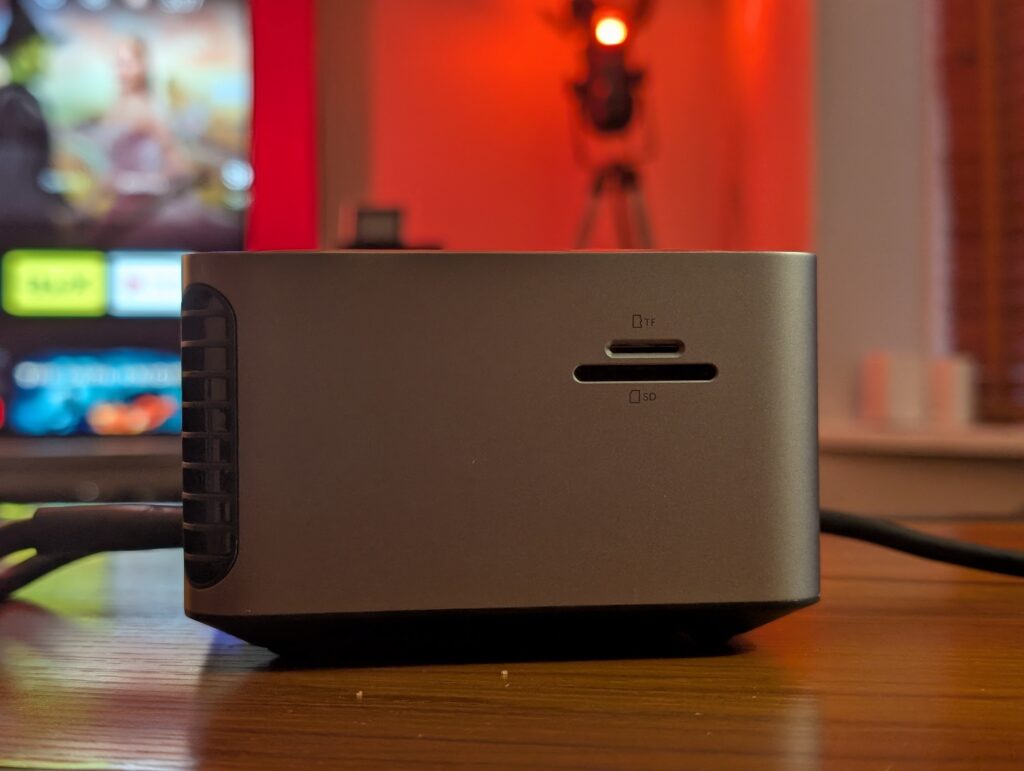
The Anker Prime TB5 Docking Station includes both SD and microSD card readers, providing a convenient way to transfer files from cameras, drones, and other devices that use memory cards. These card readers support UHS-I speeds up to 104MBps, which is adequate for most everyday use but may be limiting for professional photographers or videographers who use faster UHS-II cards.
For MacBook Pro users, it’s worth noting that recent models already feature a built-in SD card reader that outperforms the Anker dock’s reader, supporting speeds of up to 250MBps for UHS-II cards and 90MBps for UHS-I cards. Therefore, MacBook Pro users may find their laptop’s card reader more advantageous, while MacBook Air users will benefit from the dock’s slots.
2.5GbE Networking
The Anker Prime TB5 Docking Station features a 2.5 Gigabit Ethernet port, offering significantly faster wired networking speeds compared to the standard Gigabit Ethernet found on many docks. This 2.5x increase in bandwidth is particularly beneficial for users who regularly transfer large files over a local network or require low-latency connections for applications like video conferencing or online gaming.
The Ethernet port is located at the back of the dock, allowing for a clean cable management solution for permanent network connections. The port supports auto-negotiation, automatically adjusting to the maximum speed supported by your network, whether that’s 10Mbps, 100Mbps, 1Gbps, or 2.5Gbps.
Performance
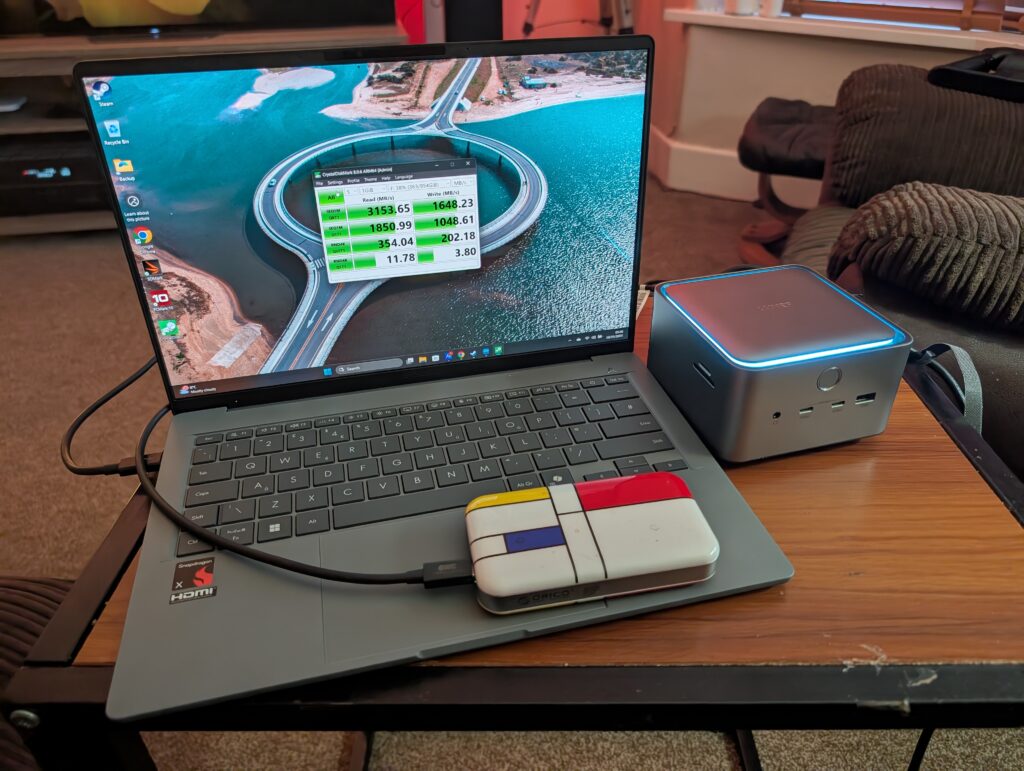
In real-world testing, the Anker Prime TB5 Docking Station demonstrates impressive performance across various use cases.
I don’t currently have a Thunderbolt 5 equipped laptop or motherboard, but I have tested it with both USB4 and Thunderbolt 4.
The highest bandwidth device I had available to test is the Orico Montage MTQ-40G SSD, which is actually USB4. With this connected to the hub, I was able to achieve peak speeds of 3153MB/s which is the equivalent of 25,224Mbps.
The dock’s cooling system proves effective during intensive operations, maintaining stable temperatures even under sustained load. The fan remains nearly silent during normal use, only becoming audible during extended periods of high-bandwidth data transfer or when multiple high-power devices are connected simultaneously.
Display performance is equally impressive, with the dock supporting high-resolution, high-refresh-rate monitors as advertised. When connected to compatible systems, 4K displays can run at up to 240Hz, providing smooth visuals for gaming, video editing, or other graphics-intensive tasks.
The 2.5GbE Ethernet port delivers expected performance, with speed tests showing throughput of approximately 2.35Gbps when connected to compatible network infrastructure. This represents a significant improvement over standard Gigabit Ethernet for users with suitable network equipment.
Thermal Management and Noise
The Anker Prime TB5 Docking Station incorporates a sophisticated thermal management system to handle the heat generated by its high-performance components and power delivery capabilities. The dock features a unique U-shaped air duct and a 4,200 RPM axial fan that work together to maintain optimal operating temperatures.
During testing, the dock’s cooling system proved effective, with surface temperatures remaining comfortable even during intensive operations.
The fan’s intelligent temperature algorithm adjusts its speed based on real-time thermal sensors, operating at near-silent 800 RPM during light loads and increasing speed only when necessary. This dynamic approach to cooling ensures that the dock remains quiet during normal use while still providing adequate cooling during demanding tasks.
In practice, the fan is barely audible in typical office environments, only becoming noticeable during sustained high-bandwidth data transfers or when multiple high-power devices are connected simultaneously. Even then, the noise level is generally not disruptive, though users in particularly quiet environments might notice it during intensive operations.
The built-in GaN power supply contributes to the dock’s thermal efficiency, reducing heat generation by 23% compared to traditional silicon-based adapters. By eliminating external power bricks and their associated heat, the system prevents localised hot spots around the power delivery components.
Overall, the thermal management system strikes an excellent balance between performance, temperature control, and noise levels, allowing the dock to maintain peak performance without becoming uncomfortably hot or distractingly loud.
Software and Firmware
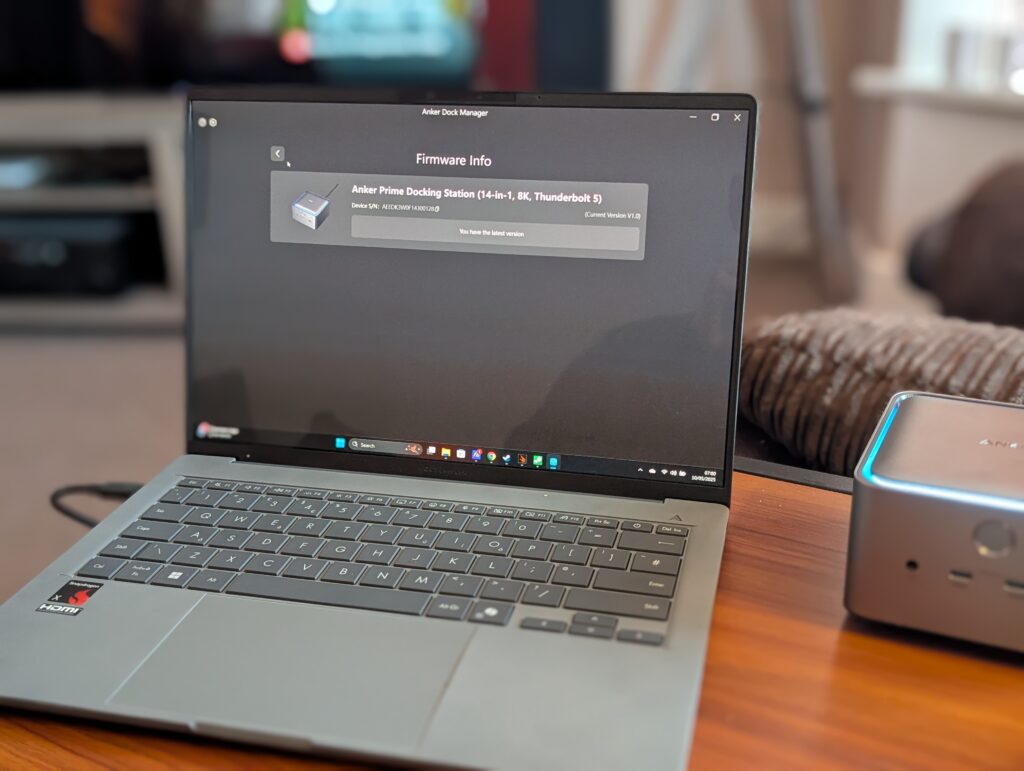
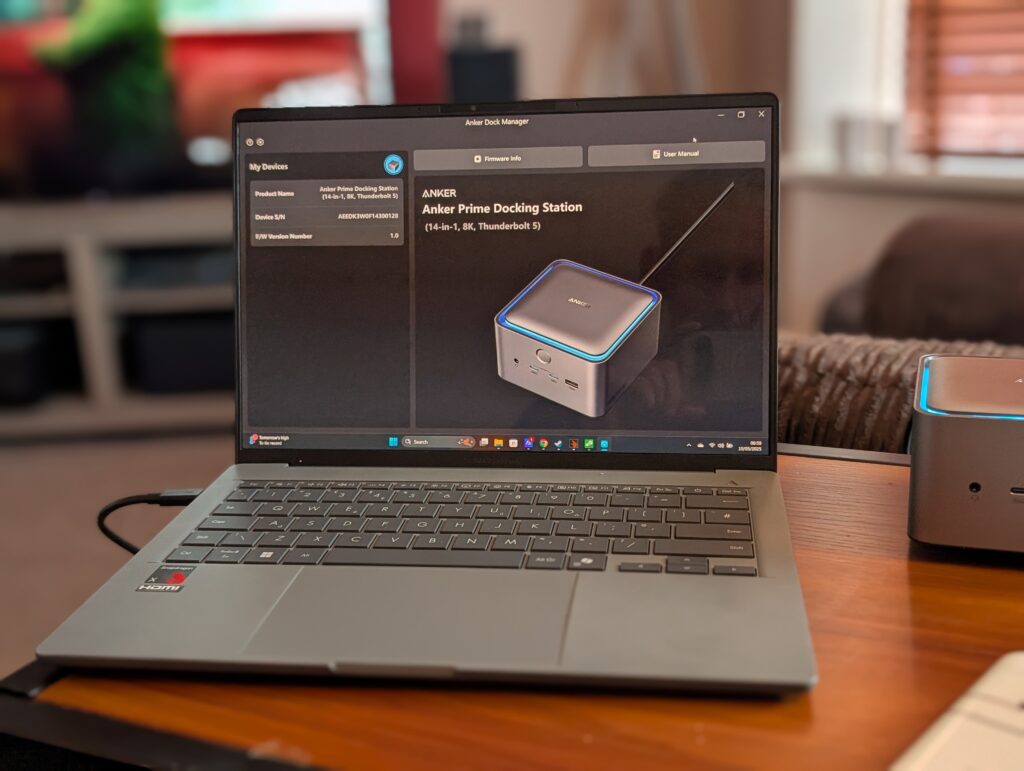
Anker provides Dock Manager software for the Prime TB5 Docking Station, offering users a straightforward way to manage firmware updates and monitor the dock’s status. The software is available for both macOS and Windows, ensuring compatibility across different operating systems.
The Dock Manager application allows for remote and model-specific firmware updates, which helps prevent unnecessary system-wide updates that could introduce instability or compatibility issues. This targeted approach is particularly valuable in environments where multiple docking stations are deployed.
Firmware updates are occasionally released to improve compatibility with new devices, fix bugs, or enhance performance. The update process is straightforward, typically requiring just a few clicks and a restart of the dock. These updates can be important for maintaining compatibility as new devices and operating systems are released.
It’s worth noting that the dock functions perfectly well without the software installed, as it operates as a plug-and-play device for basic functionality. However, installing the Dock Manager is recommended to ensure access to the latest features and compatibility improvements.
Price and Alternative Options
| Preview | Product | Rating | Price | |
|---|---|---|---|---|

| Anker Prime TB5 Docking Station, 14 Ports Thunderbolt 5... |
£399.99 | Buy on Amazon |
The Anker Prime TB5 Docking Station is available to buy now from Anker and Amazon. The RRP is £400.
There are not many Thunderbolt 5 docks yet, but the list is growing quickly:
- Kensington SD5000T5 EQ Thunderbolt 5 Docking Station is available for £350
- iVANKY FusionDock Pro 3 is available for £339 and is an 11 port dock
- Caldigit Element 5 Hub is available for £275
- Caldigit has announced the 15-port TS5, which will be available from late June 2025 in the US.
- ASUS Master Thunderbolt 5 Dock DC510 was announced at CES 2025 but doesn’t appear to be available yet.
Overall
The Anker Prime TB5 Docking Station is a premium solution that implements the latest Thunderbolt 5 technology. It has very little competition on the market, though the options that are available are slightly cheaper. Like many brands, Anker has a tendency to discount the RRP quickly after launch and I would expect this to drop to a similar level as the competing options within a few months.
With its extensive port selection, powerful charging capabilities, and advanced features like the integrated power supply and active cooling system, it offers a premium experience that justifies its price for the right users.
The dock’s standout features include its 140W power delivery, which is sufficient for fast-charging even high-end laptops; its versatile display support, allowing for multiple high-resolution, high-refresh-rate monitors; and its impressive data transfer speeds of up to 120Gbps when connected to Thunderbolt 5-compatible devices.
The integrated GaN power supply is a particularly welcome feature, eliminating the need for an external power brick and reducing desk clutter. The active cooling system effectively manages temperatures during intensive operations while keeping noise levels reasonable in most environments.
At £400, the Anker Prime TB5 represents a significant investment, and users with older devices who don’t plan to upgrade soon might find better value in a Thunderbolt 4 dock. However, for those who want to future-proof their setup or already have Thunderbolt 5-compatible devices, the dock offers excellent performance and features that justify its premium price.
Anker Prime TB5 Docking Station Review
Summary
The Anker Prime TB5 Docking Station sets a new benchmark for premium connectivity hubs in the early Thunderbolt 5 ecosystem. It delivers on its promise of top-tier performance, combining cutting-edge bandwidth, high-wattage power delivery, and thoughtful engineering in a sleek and functional design. With a robust port selection, advanced cooling system, integrated GaN power supply, and intelligent firmware management, this dock is designed for professionals and power users who demand speed, reliability, and future-proofing.
While the £400 price tag may give pause, it’s a justifiable investment for users already equipped with or planning to upgrade to Thunderbolt 5 devices. Its backward compatibility ensures current usability, while its forward-looking design makes it a long-term solution as the Thunderbolt 5 ecosystem grows.
Overall
80%-
Overall - 80%80%
Pros
Thunderbolt 5 support with up to 120Gbps bandwidth – ideal for high-speed data transfer and high-res displays
140W Power Delivery – sufficient to fast-charge demanding laptops like the 16-inch MacBook Pro
Versatile display support – supports up to two 8K or three 4K displays with high refresh rates
Advanced active cooling – maintains performance under load with minimal noise
Integrated GaN power supply – reduces desk clutter and improves heat efficiency
Backwards compatible with TB4 and USB4 devices
Cons
High price point (£400) – may not be cost-effective for users without TB5 devices
No support for Thunderbolt 3 devices
SD/microSD limited to UHS-I speeds – slower than some laptop-integrated readers
Only one HDMI and one DisplayPort – limits flexibility for some multi-monitor setups
Fan can become audible under sustained heavy loads – though generally quiet
I am James, a UK-based tech enthusiast and the Editor and Owner of Mighty Gadget, which I’ve proudly run since 2007. Passionate about all things technology, my expertise spans from computers and networking to mobile, wearables, and smart home devices.
As a fitness fanatic who loves running and cycling, I also have a keen interest in fitness-related technology, and I take every opportunity to cover this niche on my blog. My diverse interests allow me to bring a unique perspective to tech blogging, merging lifestyle, fitness, and the latest tech trends.
In my academic pursuits, I earned a BSc in Information Systems Design from UCLAN, before advancing my learning with a Master’s Degree in Computing. This advanced study also included Cisco CCNA accreditation, further demonstrating my commitment to understanding and staying ahead of the technology curve.
I’m proud to share that Vuelio has consistently ranked Mighty Gadget as one of the top technology blogs in the UK. With my dedication to technology and drive to share my insights, I aim to continue providing my readers with engaging and informative content.
Last update on 2025-07-01 / Affiliate links / Images from Amazon Product Advertising API

